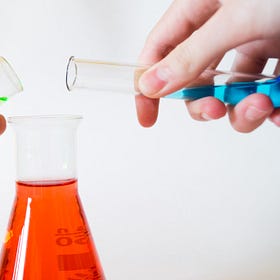Why Do We Need To Maintain A Daily Minimum Consumption Of Certain Essential Nutrients?
It’s a matter of probabilities, statistics and concentrations in our bodies.
We know that dice rolling is a highly probabilistic event. A normal die has 6 sides to it, with values ranging from 1 to 6. We’d have a 1-in-6 chance of rolling a 3 if the dice were to be perfectly balanced, for instance. Loaded dice, on the other hand, are manufactured to land more often in a certain way, such that one would be able to manipulate the outcome of a dice rolling game if they knew how it was loaded.
Otherwise, though, the probability of rolling a certain number is 1-in-6 (or 16.7%). Now, if I were to remove the 6 and put a 5 on a certain dice, the probability of me rolling a 5 would now become 2-in-6, because there would now be two sides that are marked as 5. We can then say that the probability of rolling a 5 has increased. If I change every side to a 5, the probability of rolling a 5 is, obviously, 100%.
Now, chemical or biochemical reactions in the body function in the same way. The concentration of a chemical in a solution influences its probability of reacting with another chemical, and therefore the rate of that chemical’s reaction is dependent on its concentration.
For example, if we were to have 10000 people in a room, of which 10 of them were wearing a red shirt. How easy would it be to find all 10 people wearing red shirts? For those of us who grew up reading “Where’s Waldo” comics, we’d be spending quite a fair bit of time trying to pick out Waldo from an entire page full of people.
Contrast that to the Land of Waldos, where just about everyone there is a Waldo. How much easier would it be to find a Waldo in the Land of Waldos as compared to the other places that Waldo travels to?
In the same way, we’ll see that there are so many different chemicals and biochemicals inside our body, and there are many different probable chemical reactions that can proceed as a result of all these different chemicals.
For example, Vitamin C, as we have explored previously, is something that helps to protect our bodies from oxidative damage. It is an antioxidant.
Three Important Biochemical Functions Of Vitamin C In The Human Body
When it comes to flu season or COVID season, people tend to flock to Vitamin C as this sort of a miracle drug that apparently boosts their immunity. All in the hopes that their susceptibility to an infection would miraculously be reduced to zero after they consume that 1000 mg pill (or more) for the day.
Now, antioxidants will react with pro-oxidants (most of these pro-oxidants in the body are collectively termed as reactive oxygen species, or ROS), and the transfer of electrons between the two substances will result in them neutralising each other.
Antioxidant Protection In The Body Begins From Within The Cell.
Our body is constantly in a tug of war between reduction and oxidation (redox), which basically comprises multiple reactions where electrons are being transferred from one component to another.
If the Vitamin C concentrations in our blood were significantly lower than the pro-oxidant species, we’d find it difficult to balance out the activity of the pro-oxidants with the antioxidants. If it were significantly too low, we’d end up being prone to developing scurvy, which plagued many seafarers in the past — much less protect ourselves from infectious diseases.
Hence a minimum recommended daily allowance (RDA) was instituted for Vitamin C consumption — just so that we’d reduce the likelihood of developing scurvy. It doesn’t mean that this RDA is sufficient to support our health through the additional stresses and headaches that life brings about in our lives.
The rate of pro-oxidant neutralisation by Vitamin C therefore depends on the concentration of Vitamin C in our blood. Insufficient Vitamin C could result in a pro-oxidant oxidising another innocent bystander molecule to propagate yet another ROS molecule, and the vicious cycle continues until the propagating miscreants can be subdued.
But neither does overconsuming Vitamin C mean that we will be immune to the flu, or that we’d recover more quickly if we did have the flu. A parallel to the Darwinian theory behind natural selection would emerge here.
While most of us tend to see it as the “survival of the fittest”, it was actually the case that Darwin called it the “survival of the fitter”, where the fitter ones had the best chances (or probability) to survive.
Because a good defensive system is never perfect. There will still be lapses and cracks that exist in the system. We can only try to cut down the lapses and cracks that we can cut down, and in doing so be able to improve on something that is already good, but we can’t make it 100% ultratight perfect because we aren’t all-around perfect in the first place. Nobody can claim to be that.
Name the greatest soccer goalkeeper that ever lived, and I’ll wager with you that this goalkeeper wouldn’t have been the best goalscorer at all — else he wouldn’t be in that defensive position where he excels at. Neither will the greatest goalscorer be the best at goalkeeping.
Concentrations and probabilities exist with drugs, too.
While the RDA does tell us what is the minimum for consumption, we need to know that there is a maximum too. Vitamin A, for instance, has well documented cases on toxicity — when one overconsumes the maximum allowed limit.
Some days, when our noses are runny and the histamines are raging, we may take antihistamines to quell those symptoms. Introducing antihistamines into our body allows them to block off histamine access to the histamine receptors, which would otherwise trigger the mucus secretion respose.
Process Control 2: The Effects Of Drugs On The Control Loop
Previously, in Process Control 1: Its Applications In The Human Body, I discussed the idea of how our human body has biochemical control loops that regulate its functionality.
We’d be spiking a dose of antihistamines into our body, allowing it to get into our blood and to the histamine receptors, and getting away from the triggering allergens that causes our bodies to overproduce those cytokines that lead to the overproduction of histamines. The affinity of antihistamines to bind to the histamine receptors is the key to prevent histamines from binding.
That temporarily increased spiked concentration of antihistamines brings about some symptom relief, but when they eventually disengage from the histamine receptors, we’d still face runny noses if the histamine concentration in our blood were still overpowering.
Therefore, the links that we can make between concentrations, probabilities and rates is as follows: A higher concentration leads to an increased probability of reaction, and the increased probability supports a higher rate of reaction in most cases.
It’s not an easy thing to comprehend. We need to ensure a certain minimum concentration of nutrients in our blood, hence the RDA provides some guidelines about what we ought to be consuming in our daily diets. We would have to keep in mind that these guidelines are for supporting minimum baseline operations, not aiming to achieve optimal human health.
For a high quality multivitamin, do feel free to check out the link below:
Disclaimer: This link is an affiliate link and I may receive commissions for any purchases made via the link.
Also ,do feel free to share this article and hit the “subscribe” button to get more updates about the science concepts in nutrition and health, all deconstructed nicely for your convenient perusal!







